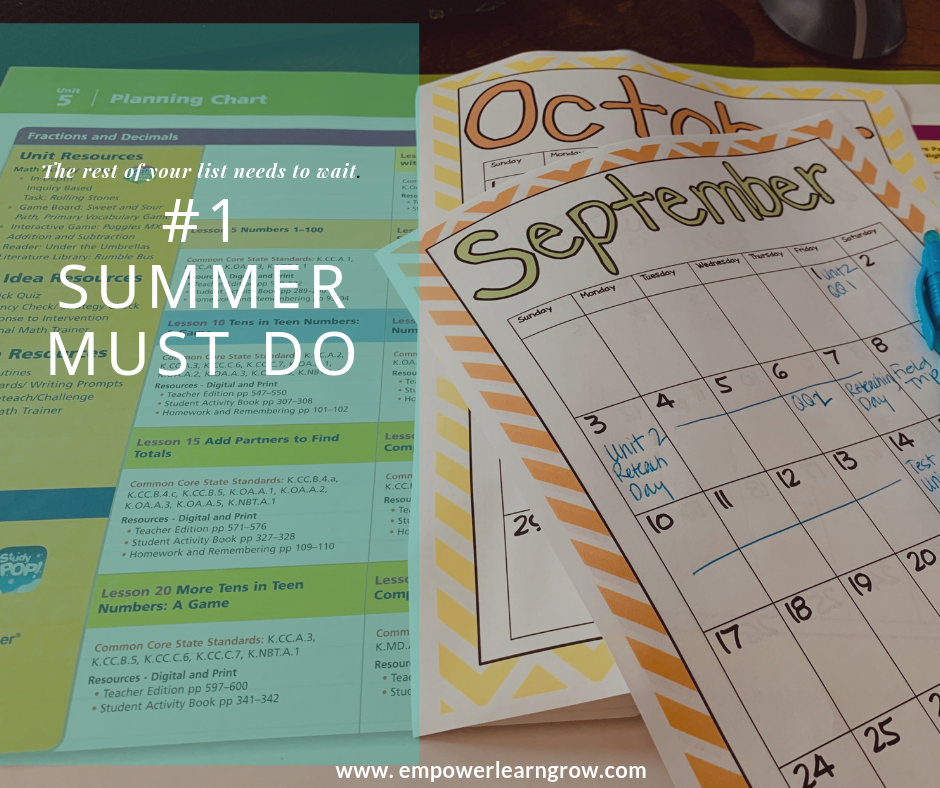
27 Jun #1 Summer Must Do
If your list is as long as mine, you are already wondering how you might get it all done before the start of next school year. Every little thing I couldn’t focus on, or fit in this school year went on my “I’ll work on that this summer” list.
Well, golly gee… here it is summer and there are more to-dos than there are days in the season. Because I’m committed to taking care of myself and getting some down time too, I’ve decided to prune my list into the most essential tasks before August. I often get caught in the rabbit hole of social media: Instagram, Pinterest, even Teachers-Pay-Teachers. I see these ideas that lead to other ideas. Here I am looking for a lesson plan template and the next thing you know, I’ve decided to completely change the theme of my entire classroom (or in my case my office). It’s no wonder I start every school year a bit disappointed that I didn’t really accomplish my summer goals!
So, friends, I’m here to help. If there is ONE thing you should do to prepare for the next school year in terms of your mathematics instruction, it would be to PLAN.
Yes, the nasty four letter word that sucks the life out of most educators. P…L…A…N. PLAN. But not the meticulous weekly plans. If you have lots to cover this summer, I first suggest doing a year at a glance plan.
I speak with teachers all year long who are panicked about finishing the curriculum or are panicked about teaching all of their standards in the amount of time they have. My first question is, “Well where does your year at a glance say you should be?” I’m often greeted with blank stares. “Year at a glance? What’s that?”
Uh-oh.
Well, that might be why you are panicking.
Or, the other extreme. “Well, where are you in your yea- at-a-glance?” Response: “ Like, two months behind.” Yikes. I’d be worried too. Most likely, these teachers are too focused on doing every single problem in every lesson. They are teaching lesson by lesson instead of topic by topic.
Neither of these responses are ones I’d hope to hear. Not having a plan is a pretty big worry. Being way off the plan is a pretty big worry. Two weeks off? I’m not concerned.
For those of you who haven’t planned: make a plan. I know. I know. Shouldn’t the district do that for you? Well, for many of you, they do. And mostly these are done with the purest of intentions and based just on the facts as they are outlined in the curriculum. But there is something about being the person IN the classroom planning out how long something will take that carries much more power. If you are a part of the plan, it changes how you view the plan. When you create the plan, you know the intricacies of the decisions, the sacrifices that needed to be made, the possible lessons that needed to be combined, etc. Also, 90% of the year-at-a-glance maps I look at (completed by the district) have significant errors. This isn’t intentional, of course, but it is frustrating to teachers. Frustration leads to mistrust or bitterness, neither help our cause. Use the district’s guide as a GUIDE. But do your own plan and compare it to what they’ve outlined. I bet they will be pretty close, but because you did the planning you will ‘get it’ better, be a better teacher, and be overall happier with the pacing.
I am not suggesting you go rogue. All of my leadership friends might be a little worried right now that I’m leading you down that road. I’m NOT. You need to use the district plan as a guide– I’m not saying abandon it. I am saying you need to internalize it and make it your own so that you have buy-in and believe it can be done.
Friends, we can’t do it all. So we need to look at our school calendars and do a general outline of how long each topic should take based on our day’s schedules, district school days, and our experience with that grade level. It is just a fact: when we are a part of the solution, we are happier people. Read any major business journal about happy and unhappy employees and most of the unhappy employees are unhappy because their employers have unrealistic expectations about what can be accomplished in their work windows. BUT when that same employee is a part of building the calendar of deliverables, they still may have a lot to fit in, but they see all of the pieces. They see the whys, the hows, and the why nots. There is less stress, less complaining, and more of a team “WE CAN” attitude.
Plan your year at a glance. Grab a blank calendar, one that isn’t for ANYTHING else. And by yourself or preferably with your team, do the following:
The FIRST DRAFT:
- Fill in your school dates:
- The first day, last day, days off, field trip days, etc. Anything that would interfere with math instruction.
- Testing dates. These interfere with normal instruction and therefore need to be included as days you don’t have to teach content. It also helps you decide which units/standards need to be taught prior to those testing windows.
- Count the units and the lessons. For each unit, give yourself one day per lesson (or follow the publisher’s guidelines), one day for each unit test, and at least 2 days for reteaching. Use this as the bare-bones plan. This is the, “if it were to all go as planned plan.”
- Mark off each unit with the number above on your school calendar. Note when you start the unit and note the last day (assessment or reteaching day).
- Repeat for the entire year.
SECOND DRAFT: Now that you have your original draft, my guess is you didn’t have enough time or space. If you did, glorious! Go back and add in a day for each quiz and a reteaching day for each quiz. Add in a second lesson day for those lessons YOU KNOW will need more than one day. Use the publisher’s outline as another resource to check your decisions against.
If you didn’t have enough time, now begin to do the pruning but first, be well informed:
- Consult your state standards. KNOW the priority standards, major clusters, minor clusters, etc. Many states (& districts) have created their own priority standards. Use these documents to ensure you really know those big ticket standards. Please be careful here. Some districts are so focused on priority standards (that they dictated) that teachers omit teaching anything that is NOT a priority standard. Priority standards are to help teachers to focus time and intensity, they are NOT the only thing you are teaching. Priority standards fit into the progression of standards. Skip around and you will likely impact next year’s priority standards and or you are just going to be really unhappy with how disjointed your instruction feels. If you are a common core state, I highly suggest Achieve the Core: https://achievethecore.org/coherence-map/. They have great resources to help you identify the major clusters of each grade level.
- Consult your testing materials, released items, graphs, etc. Most states have fantastic pie graphs and such that will tell you how much of the test is on which standards. This should really be taken into consideration when you are considering the amount of time to spend on each unit. We are just becoming well informed before we look at the units. I do not believe tests are everything, but they are a part of our reality. We don’t skip standards or content if they aren’t on the test, but we also need to be mindful of the time we do spend on them. There are many cases for the testing grades where teachers don’t have to fit in the entire unit before state testing and they can move big ideas to after testing which frees up time in the pacing guide.
Next, identify each unit’s main concepts (standards), methods, and models. BE FOCUSED. You can’t do it all, so you will need to consolidate some lessons or group them based on ‘topic.’
Consider:
-
- Unit order. In general, most curriculums follow a very specific progression that coincides with how topics are learned/taught. It is generally best practice to follow the publisher guidelines. However, this isn’t always true and things like state testing impact these guides. Make minimal rearrangements as needed. If you find yourself moving everything, all over, you are probably moving things too much and are doing it based on preference rather than on research-based knowledge of how concepts are learned.
- Think Big Picture, not isolated lessons. I’d rather you say we have 6 days to cover comparison bars, instead of saying we have 6 days to cover 10 lessons. Pull the big ideas out of those 10 lessons and make the instruction manageable and focused on the most important models, language and methods. You now have 10 days to teach that list. You will use the lesson content to help you during those ten days, but if you try to do each lesson every day, you will fall behind and become a drill sergeant who is more concerned with doing every part than that kids are doing the thinking and the learning.
- Less is More You can’t skip entire topics or standards. Although many people do, in the big vertical lense, this is really harmful. Standards build upon each other and when everyone continually runs out of time for ‘geometry’ 5th & 6th grade really get sucker punched because they now have much higher level skills to accomplish with zero foundation. So, in honor of less is more. Teach the standard, but teach fewer lessons more in-depth.
There is never a foolproof way to ensure you are totally at peace with your pacing. The reality is even with standards shifting, there are too many. So, we must be more intentional about the quality of our teaching. Do fewer problems, better.
This year-at-a-glance will help you to remain committed and accountable to getting in all of the standards. It will also help you from panicking. I have some teams that finish really early every year. This is not ideal either and is a product of poor planning. When this happens, it means we sped through concepts that we know kids needed more time learning, out of a panic that we wouldn’t finish.
I like omelets. But I’m on a time crunch and have to get out the door. I’m committed to having a healthy omelet each day. So, I throw everything into the pan — my veggies, meats, etc. Because I’m rushed, I don’t take time to saute them correctly. I pour in my eggs. But time. Oh, I gotta go. So, I quickly flip my omelet. Scrambled Eggs. Darn it. Well, no omelet now, I’ll have to settle for scrambled eggs. No problem, same idea. I pour them onto my plate. I take my first bite and spit it out. The meat is still raw. The veggies too tough. My husband looks at me knowingly and says, “You should have either chosen to be late or to not have all of those ingredients. You didn’t have time for both.” (He’s a better guy than I give him credit for here.)
Friends. You don’t have time for it all. Fitting it all in for the sake of fitting it all in, and you’re going to have undercooked (under taught) standards, a messy version of understanding, and raw concepts not fully developed. Either take something out or commit to being late. ORRRRRRRRRRR the better plan is to PLAN AHEAD AND MAKE TIME FOR THE IMPORTANT PARTS. The original problem with my breakfast was I was running late. Why? Because I wasn’t well planned for the morning. I went into the morning without a timeline of how to get everything I needed to be done, the way I wanted it done, in the time that I had.
A LACK OF PLANNING was the true source of my issues.
Don’t be me.
PLAN for your year. Get all of the important stuff cooked the way it should be. Get all of the important concepts taught the way they should be.
We can avoid getting two months behind if we have a plan we believe in. This is not to say you still won’t get behind for various reasons, but that, my friends, is a topic for another day.



Dawna Brandt
Posted at 00:39h, 28 JuneThank you for the details! I appreciate your ideas on how to plan and therefore, have a better year.
Marni Posl
Posted at 17:50h, 29 JuneI am excited to get our plan done before August. I appreciate your ideas…here’s to a fruitful summer.